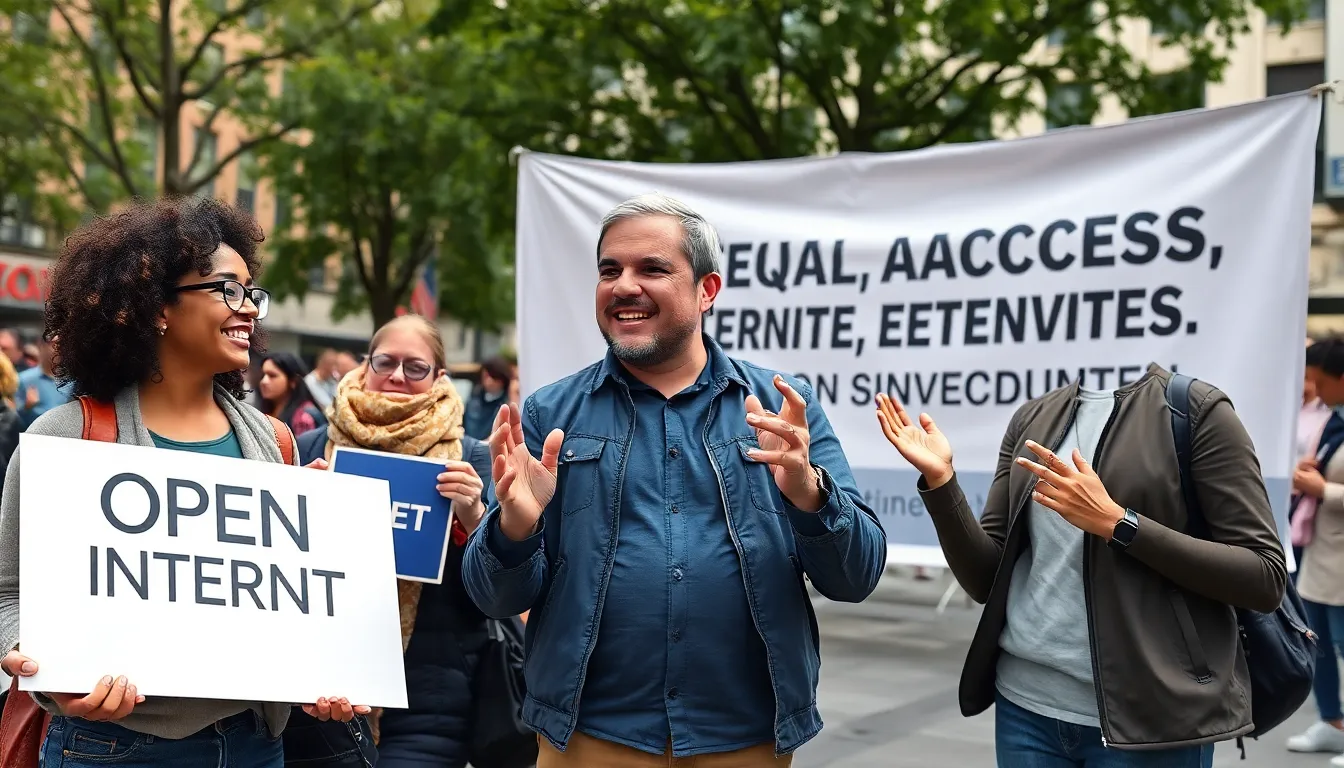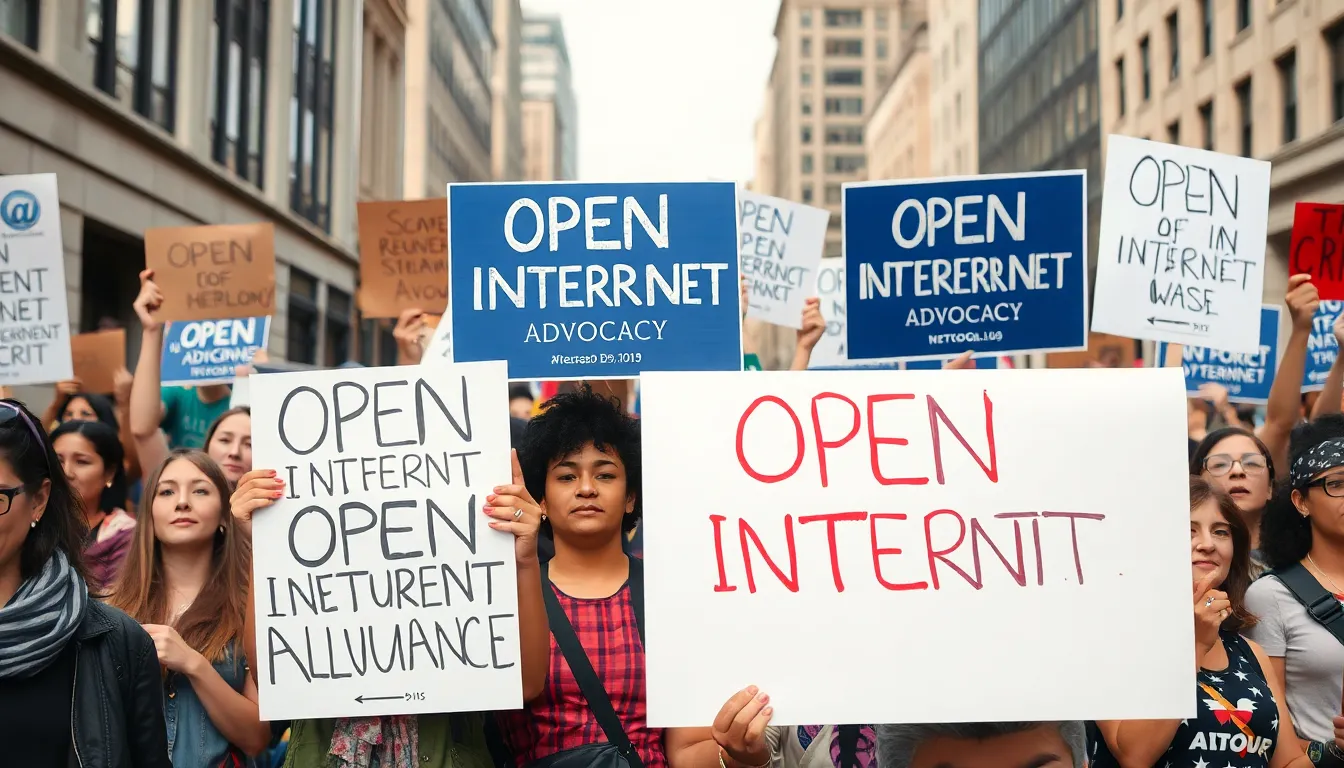In a world where cat videos and memes reign supreme, the open internet stands as the ultimate playground for creativity and expression. But what happens when that playground gets fenced in? Open internet advocacy fights to keep the digital doors wide open, ensuring everyone can surf freely without fear of censorship or throttling.
Imagine a world where your favorite online haunts could suddenly vanish or become painfully slow, all because someone decided your browsing habits weren’t “up to standard.” Sounds like a bad sci-fi movie, right? That’s why advocates are rallying to protect net neutrality and promote a truly open internet. They believe that everyone deserves access to the vast ocean of information, innovation, and yes, even the latest dance challenges. Together, they’re working to keep the web a vibrant and inclusive space for all.
Table of Contents
ToggleOverview of Open Internet Advocacy
Open internet advocacy focuses on preserving access to an uncensored and unrestricted online landscape. Advocates support net neutrality principles, which involve treating all internet traffic equally. This principle prevents internet service providers from differentiating access based on content, user or platform.
Efforts in this arena include campaigns, legal actions, and public outreach. Organizations such as the Electronic Frontier Foundation and Public Knowledge play crucial roles in these initiatives. They gather data, conduct research, and influence policy to highlight the significance of digital rights and open access.
Public support remains essential for successful advocacy. Mobilizing communities and raising awareness fosters a collective voice demanding equitable internet access. Various platforms, including social media and blogs, contribute to these efforts by sharing informative content and encouraging open discussions.
Challenges persist in achieving comprehensive open internet policies. Legislative measures and corporate interests often clash, making it vital for advocates to remain vigilant. Continuous monitoring of internet regulations aids in addressing emerging threats to digital freedom.
Global collaboration enhances advocacy effects, allowing for diverse perspectives to unify against internet restrictions. Connecting with international movements amplifies local efforts and creates a more robust front against censorship.
Engagement in open internet advocacy represents a commitment to fostering a free and accessible digital world for all users.
Historical Context
Open internet advocacy stems from a need to protect unrestricted online access. This movement emerged in response to evolving technologies and regulatory systems.
Development of Internet Regulations
Various regulations shaped the internet’s landscape since its inception. The Communications Act of 1934 aimed to promote telecommunications but did not address internet-specific issues. The 1996 Telecommunications Act marked significant changes, allowing competition and encouraging innovation. In 2010, the FCC established the Open Internet Order, which outlined net neutrality principles. These principles sought to prevent internet service providers from discriminating against content or applications. However, the rules faced legal challenges that led to their repeal in 2017, creating uncertainty around internet access standards.
Key Milestones in Advocacy
Significant events highlighted the push for a free internet. In 2010, advocacy groups rallied for the Open Internet Order, uniting various stakeholders. The 2014 protest known as “Internet Slowdown” raised public awareness of net neutrality concerns. Organizations like the Electronic Frontier Foundation and Public Knowledge organized campaigns to mobilize communities. In 2017, millions voiced their opinions against the repeal of net neutrality regulations through public comments and protests. Legislative efforts, such as the introduction of the Save the Internet Act in 2019, aimed to restore protections and ensure equitable access for all users.
Current Landscape
The current landscape of open internet advocacy highlights ongoing efforts to preserve unrestricted online access. Advocates continue to face challenges while pushing for net neutrality and equitable internet access globally.
Major Organizations and Their Roles
Organizations play vital roles in open internet advocacy. The Electronic Frontier Foundation focuses on protecting user rights and privacy in the digital space. Public Knowledge champions policies that encourage creative expression and innovation. Fight for the Future mobilizes grassroots support through campaigns and events. Similarly, the Coalition for Internet Openness brings together diverse groups to strengthen the movement. Each organization channels resources toward education, litigation, and lobbying efforts, greatly impacting public perception and policy.
Legislative Developments
Legislative developments shape the open internet landscape significantly. In 2019, the Save the Internet Act sought to restore net neutrality protections after the 2017 repeal. Lawmakers introduced this bill in response to widespread public demand for maintaining equal access. Various state-level initiatives also emerged, as some states enacted their own net neutrality regulations. Legislative debates often reflect the tension between corporate interests and consumer protections. Observing these developments provides insight into the ongoing battle for internet freedom and access equity.
Impact on Society
Open internet advocacy significantly shapes society, influencing both individual freedoms and economic ecosystems. By ensuring access to uncensored information, it fosters an environment for diverse voices and ideas.
Effects on Freedom of Speech
Freedom of speech flourishes within an open internet framework. Users express their thoughts freely without fear of censorship from internet service providers. Discussions about critical issues thrive when all viewpoints receive equal visibility. The ability to freely share information empowers communities, enabling them to mobilize for social change. Additionally, public forums become vibrant spaces for dialogue, reflecting society’s rich tapestry of experiences and perspectives. Without net neutrality, marginalized voices risk suppression, leading to an imbalanced representation of ideas online.
Economic Implications
Economic implications of open internet advocacy are profound and multifaceted. Equal access drives innovation, allowing startups and small businesses to compete with established corporations. A level playing field encourages the development of diverse online services and products, fueling economic growth. Access disparities could hinder economic opportunities, especially for rural or low-income communities. Moreover, the digital economy thrives when users tap into a variety of services without facing throttling based on their financial status. In essence, preserving an open internet supports a robust and dynamic economy, fostering both competition and creativity.
Challenges Facing Open Internet Advocacy
Open internet advocacy encounters several significant challenges. Advocates strive to maintain a free and accessible digital space while addressing these obstacles.
Corporate Influence and Lobbying
Corporate influence severely impacts open internet advocacy. Internet service providers often prioritize profit over equitable access, using lobbying efforts to sway legislation in their favor. Organizations spend millions on campaigns, influencing policymakers to support measures that benefit their interests. The opacity in lobbying processes limits transparency, making it difficult for the public to understand corporate motivations. Stakeholders must navigate relationships with these companies, sometimes compromising the advocacy goals. Grassroots efforts continue to counter corporate lobbying, emphasizing the necessity for public participation in policy discussions. Collective action encourages lawmakers to prioritize the needs of consumers over corporate profits.
Technological Barriers
Technological barriers pose another challenge to open internet advocacy. Many people lack reliable internet access due to infrastructure inadequacies, which disproportionately affects low-income communities. Inadequate broadband access creates a digital divide that restricts opportunities for education, employment, and social engagement. Rural areas often experience slower connection speeds and limited service options, exacerbating inequality. Furthermore, various platforms introduce algorithms that limit user access to information based on preferences or usage patterns. Technologies developed without considering user rights can hinder advocacy efforts aimed at ensuring equitable access. Advocates focus on addressing these barriers to promote a more inclusive and accessible internet landscape.
Conclusion
Open internet advocacy remains a critical endeavor in today’s digital landscape. As challenges arise from corporate interests and technological barriers, the commitment to preserving equitable access grows increasingly vital. Advocates continue to champion net neutrality principles, ensuring that all users can navigate the internet freely and without hindrance.
The collective efforts of organizations and individuals play a crucial role in shaping policies that protect user rights and promote innovation. By fostering public awareness and participation, the movement for an open internet can thrive. The future of a vibrant digital space depends on ongoing advocacy and the united voices demanding fairness and accessibility for all.








